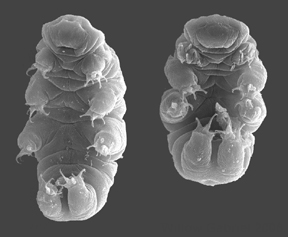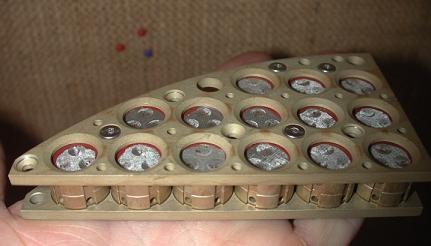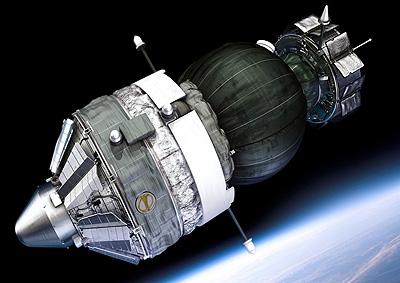Tardigrades are small animals probably related to the proki-limbs (insects). The largest adults of the species reach a length of 1.5 millimeters sent to stay in space conditions. The capsule has already landed but did they manage to survive? We will wait and see

In the picture: tardigrades (from Wikipedia)
Life in space - a journey of the tardigrades
"For the first time in the world, animals have now been exposed to outer space, to the harsh conditions of vacuum and cosmic radiation," says ecologist Ingmar Johnson, a researcher at Kristianstad University in Sweden.
Tardigrades are small animals probably related to the proki-limbs (insects). The largest adults of the species reach a length of 1.5 millimeters. They live on lichens and mosses, but can also be found in dunes, beaches, dirt, and saltwater and freshwater sediments (where up to 25,000 animals can often be found per liter). The tardigrades can survive in extreme conditions that would kill almost any other animal. They can survive in temperatures approaching absolute zero (-273°C) as well as high temperatures of 150°C. They are immune to radiation 1000 times more than any other animal, able to survive almost ten years without water, and even withstand a vacuum similar to that in space.
One of the goals in sending the tiny tardigrades into space was to find out if they could handle the harsh conditions in space. Predictions state that they are capable of this, but this has never been tested.
The tardigrades are among the animals in the world resistant to dehydration and radiation - a feature necessary to survive the journey in outer space. But the project is also part of the research examining the basic physiology of tardigrades, and especially the mechanisms that allow them to resist dehydration.
The project, known as 'TARDIS', was chosen by the European Space Agency to be one of the ten European projects that are given the opportunity to carry out scientific experiments in a real space environment.
Exposing organisms to the outer space environment provides us with knowledge about the reaction of living cells to harmful factors in space. There are few groups of animals that are able to travel through space alive, and they will be an important source of knowledge if and when the time comes to establish ecosystems in space.
The tardigrades were carried into space by the Photon-M3 spacecraft, which has been orbiting the Earth for the past twelve days. The capsule containing the tardigrades landed successfully on September 26 in Kazakhstan. The unmanned spacecraft carried 43 European experiments from a wide range of scientific disciplines, such as fluid physics, biology, crystal growth, radiation exposure and exobiology. The mission was overseen by 65 engineers and scientists in Asaranja, Kiruna, Sweden and Russia.
Immediately after the capsule landed, helicopters were launched to the scene. No damage was detected to the vessels holding the tardigrades, and they were returned to the Swedish laboratory on the fourth of October. Now the researchers plan to test the softer part of the experiment - the tardigrades. This part of the experiment is expected to last several months. The survival of the animals exposed and not exposed to space will be tested, and their reproductive patterns will be documented. The process of assessing the damage to their DNA will begin soon.
Only when all these analyzes are finished, will we know if the tardigrade space pioneers really survived their journey in space.
The tools that hold the tardigrades on their journey through space
Third image: The photon-M3 capsule, carrying the tardigrades, the space pioneers.



6 תגובות
I see no reason why there is no life in outer space as there is life in our planet there is no reason why there should not be life
in the whole universe.
Maybe these are lives that we are not cases of, but we will get to know them over time, what is their intellectual level, how do they function
What are the conditions in which they live, all this is the subject of deep and serious research and I think that with the progress of the study of life
In space we will receive answers that may surprise us.
We focus on looking for a place where we can live for our planet and we don't focus on finding life and it doesn't matter what form of life or creatures maybe they are even creatures that we need to learn about and maybe on the contrary they are on us time will tell.
Keep up the holy work
Golan Panchasio
We'll talk by email.
Hi... I'm really sorry, but I'm not commenting on the article, I just need your help.
I am now doing a dissertation on the growth of the vampire myth. I looked for information about this on the Internet, and along the way I saw that two years ago you gave a lecture on this topic at the 2005 Icon Festival.
I would really appreciate it if you could help me by giving me material you have…
I would appreciate it if you would contact me via email: spiderpig91@hotmail.com
Thanks in advance! 🙂
First -
I couldn't find a real explanation of where the tardigrades entered the Photon-M3.
In any case, even if the tardirgiids represent some primitive multicellular organism that came from space (which I doubt, because they are related to the arthropods, and we see patterns of development in evolution that are simply distant from the arthropods and not 'passing' through them) to go through a very heavy evolution to become the great zoological wealth we have today.
my people -
It really sounds like a fascinating experiment, but to be honest, I hope to find more beneficial uses for the moon in the near future. Apart from that, according to the current rate of development of the sun, in 500-600 million years life on Earth (not to mention the moon) will be unbearable due to the extreme heat.
(The time frame was taken from Wikipedia, so there may be some error here)
Yes, fascinating creature. It could be a good candidate if we find available water on the moon for example and prove beyond any doubt that there is no life on it, we can send a quantity of this insect there and see if it manages to grow and develop there together with microbial fauna. The moon as an evolutionary laboratory disconnected from the earth. In a billion years, when the temperature here will still be relatively reasonable, strange and large animals will certainly be able to develop there to suit the lunar environment.
I didn't understand from what was written what they did with them -
Did they put them inside the satellite? outside of it?
in a container? On a stone?
In any case, a fascinating experiment on a fascinating creature, which can possibly verify or disprove the hypothesis that the genetic basis common to most animals (such as head, neck, center, etc.) may have originated from organisms that did come from space.
And maybe just... evolution!